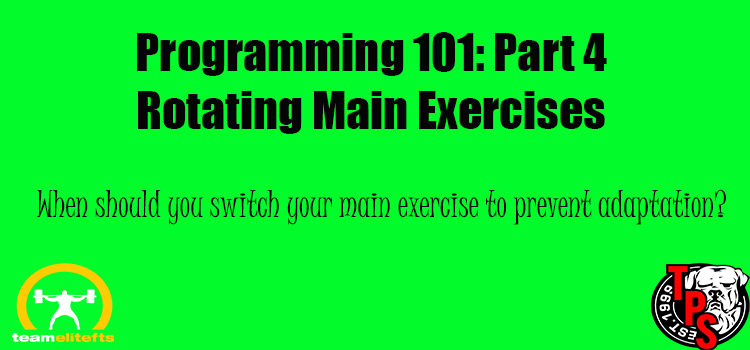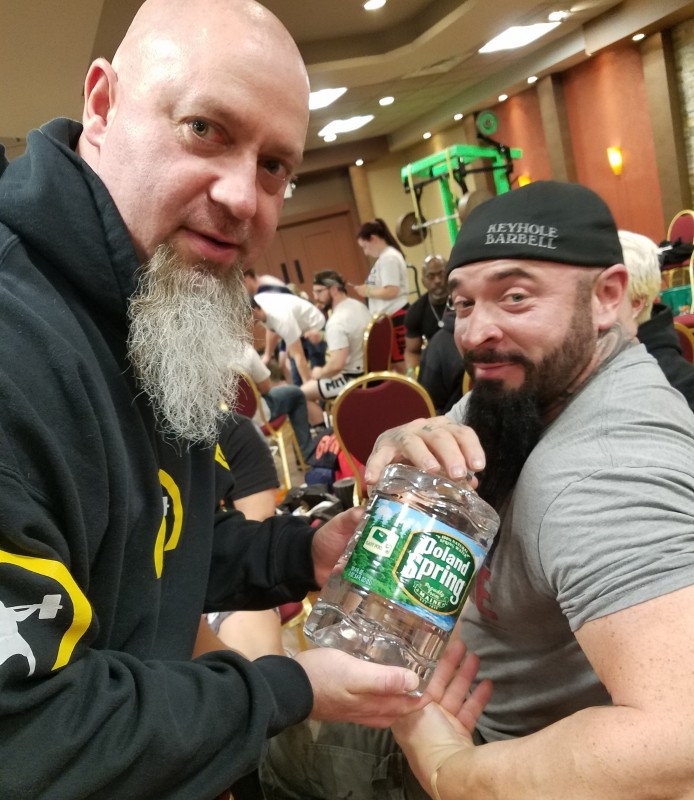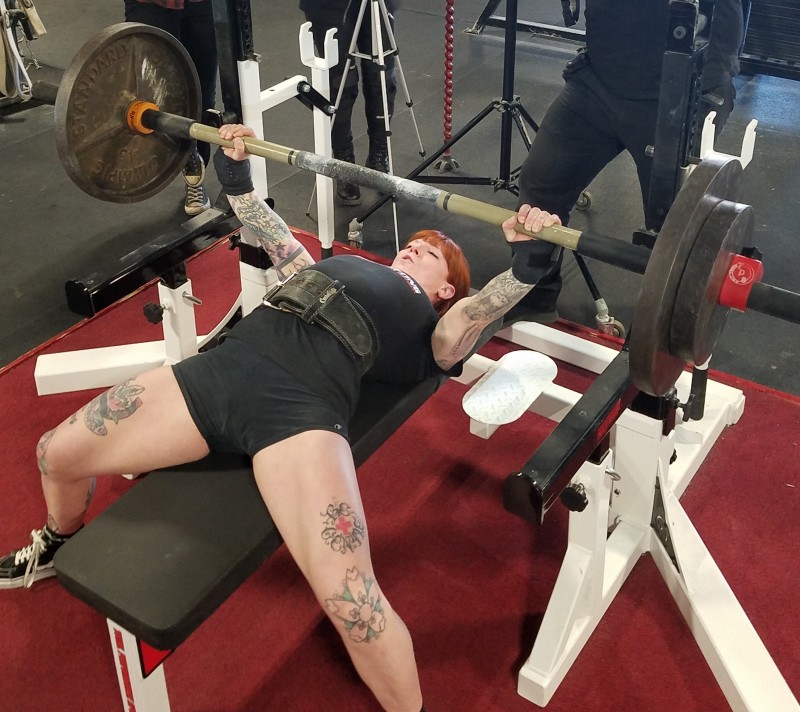
I hope that you’ve been reading my Programming 101 series and I also hope it is shedding some light on how to set up a program.
This week I am tackling an issue that gets a lot of attention and also has a lot of opinions.
I’ll give you mine and the why’s on the matter of How often you should be Rotating Your Main Exercises.
We are discussing the fist lift in your program, the big one.
It’s usually going to be a Squat, Bench Press or Deadlift variation, but it could be many other things if you aren’t a powerlifter.
A Strongman for example may have some type of Press first, or maybe Clean variation.
Whether you are a powerlifter, a Strongman, or a coach programming for adult fitness clients, it all works.
Some say that you need to rotate exercises every week, some say every two weeks, or three weeks, and some say longer.
Who is right? Well, all of them. It depends on your goals and what you expect from the program.
But.
There’s always a but.
I have my own opinion and it has been formed through education, talking with tons of coaches, and my own experience writing countless programs and training countless lifters.
I think Swede Burns said it best in a conversation we had in my office, and I’ll paraphrase.
Swede, don’t kill me if I mess this up, the spirit of the conversation is here.
He said that you need to change the means when it loses its effectiveness. What he meant is that once you’ve adapted to an exercise variant (means) you need to make a change or it will not give the desired result.
Let’s use a Squat as the example. If you are doing plain old Squats as your first exercise and you are stagnating, you need to change it.
It doesn’t mean to stop squatting.
Add a variation. Like a pause, or add chains, or bands, or a new bar. Get it?
So how do we know when it loses its effectiveness?
Easy, you stop making progress.
But, why wait until you stop making progress to change?
That seems counterproductive and I am sure my bearded friend will agree. Keep the progress coming.
Let’s look now at the time period you do each lift for and why. Many coaches say that lifters need to rotate exercises each week to prevent adaptation, and they are correct. You can’t adapt if you do something different each session. But do most of us need that?
I would say no.
Beginners and intermediates, which is a huge percentage of the people that most of us coach, do not need to change each week, and I would stress that they will not master the lifts as effectively doing this.
Of course you can point out the high level athlete that squats 800 pounds raw and does a different lift each week. Guess what? You aren’t that guy and neither are most of your clients.
You can argue anything if you are that type. Don’t be that type.
Other coaches say every two weeks.
Two weeks is a nice choice for a lot of people. It gives you two weeks work at the lift and then a small variation to it will keep progress rolling.
How about three weeks?
This works well too. This gives a slightly longer amount of time to build mastery, and mastery is good.
Four weeks?
Yup.
Five weeks?
Maybe, but you could be pushing it here unless you are dealing with true beginners. I think true beginners will benefit from much longer periods using the same exercise as they need to learn how to perform the classic version of each lift before learning variations. And yes, there are coaches who don’t agree with that. To them I say, ok, it’s America and you can do what you like. If it works for you and your clients, keep it up.
Here is where I stand on How long should you keep your main lift in the program.
I like 2-4 week waves. Usually 3 is a sweet spot. But. There’s always a but.
I change the way the same lift is applied and that allows us to use the same exercise for a longer period of time without adaptation. I do this a lot with my program the Total Performance Method and the TPS Method for Powerlifting.
This can be done with Volume/Intensity changes as well as accommodating resistance changes.
Here is an example:
- Week 1: Squat with 1 chain per side
- Week 2: Squat with 2 chain per side
- Week 3: Squat with 3 chain per side
You can see the lift is the same but the addition of more chain prevents adaptation.
Here is another:
- Week 1: 1/1000 Paused Bench Press
- Week 2: 2/1000 Paused Bench Press
- Week 3: 3/1000 Paused Bench Press
Again, the exercise is the same, but the pause is different. Or,
- Week 1: Deadlift with 2 chains per side 5x5 RPE 7/70%
- Week 2: Deadlift with 2 chains per side 5x5 RPE 8/ 75%
- Week 3: Deadlift with 2 chains per side 5x5 RPE 9/80%
Same exercise each week, same volume, higher tonnage.
Tonnage is the total weight lifted. Let me illustrate using the example above.
Assuming a 405 deadlift, weights for each week look like this:
Week 1: Deadlift with 2 chains per side 5x5 RPE 7/70%-280 pounds 1400 pounds volume per set (280 x5), 7000 pounds total tonnage (1400 x 5 sets)
Week 2: Deadlift with 2 chains per side 5x5 RPE 8/ 75% -300 pounds 1500 pounds volume per set, 7500 pounds total tonnage
Week 3: Deadlift with 2 chains per side 5x5 RPE 9/80%-325 pounds 1625 pounds volume per set, 8125 pounds total tonnage
You can see that while the exercise is the same, the increase in tonnage prevents adaptation because even though the lift is the same exact movement, the stressor (percentage of 1 rep max) is different.
It is hard to adapt to a heavier weight. If you just kept them at a 5x5 using the same weight they would adapt quickly and effectiveness would probably be lost on Week 3 using the above example.
These are just a few examples of how you can keep progress coming without rotating exercises too frequently.
To sum it up, here is what I think is best:
Beginners: spend a long time reinforcing technique and mastery, but don’t change the classic lift. Change the sets and reps. How long is a long time? It could be weeks, months or longer.
That is where you as the coach has to use a calibrated eyeball and see what is going on.
Make changes when things stop working.
If it ain’t broke, don’t fix it.
Intermediates/Advanced lifters:
Two to four weeks, and then change. Again, you need a calibrated eyeball. Watch your athletes and pay attention.
- 2-3 weeks for the more advanced
- 2-4 for intermediates
- 3 is the sweet spot.
And, did you miss my log last week? If you did, check it out:
Interview with Kyle Power of TPS
Ask me a question-Be sure and Type to Murph in the header
Find me on Google-search for Total Performance Sports Malden, Mass.
The Best Gym in Boston
Facebook too.
Oh, yeah, follow us on Instagram too. TPSMalden
SHARE THIS!
#bostonsstrongest
By: C.J. Murphy
April 26, 2018












